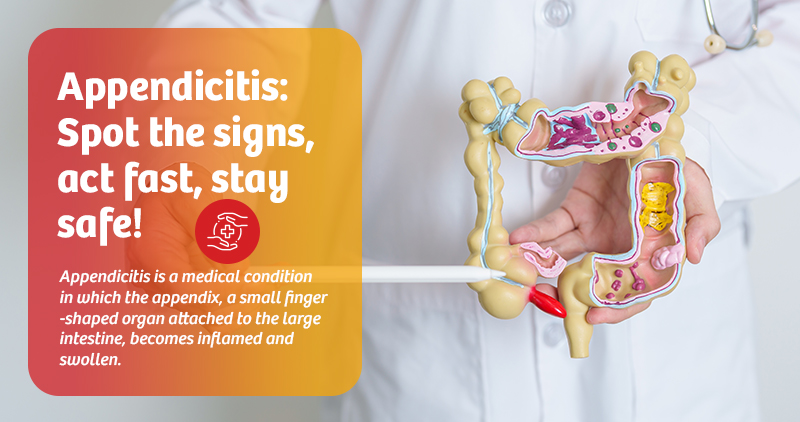What is appendicitis?
Appendicitis is a medical condition in which the appendix, a small finger-shaped organ attached to the large intestine, becomes inflamed and swollen. This condition is considered an emergency because a ruptured appendix can lead to a severe infection called peritonitis, which can be life-threatening. Appendicitis is most common in people between the ages of 10 and 30, though it can occur at any age.
Causes of appendicitis:
The exact cause of appendicitis is not always known, but it is usually due to obstruction or infection in the appendix lumen. The following factors may contribute to appendicitis:
- Blockage of the appendix opening: This is the most common cause, often due to faecal matter (faecolith), a foreign object, or thickened mucus.
- Bacterial or viral infections in the digestive tract can cause swelling of the lymphatic tissue in the appendix, leading to a blockage.
- Gastrointestinal Disorders: Conditions like Crohn’s disease or ulcerative colitis can contribute to appendix inflammation.
- Trauma or injury: In rare cases, abdominal injury can lead to appendicitis.
- Genetic factors: Some studies suggest a genetic predisposition to appendicitis in certain families.
Symptoms of appendicitis:
Appendicitis symptoms can vary depending on the severity of the inflammation, but the most common symptoms include:
- Abdominal pain: The pain usually starts as a dull ache near the navel and
then moves to the lower right abdomen. The pain becomes sharp and severe over time.
- Nausea and vomiting: Often follows the onset of pain and can persist.
- Loss of appetite: A sudden disinterest in eating.
- Fever and chills: A mild fever that may worsen as the infection progresses.
- Swelling in the abdomen: Due to the inflamed appendix.
- Digestive issues: Constipation, diarrhoea, bloating, or difficulty passing gas.
- Pain worsening with movement: Coughing, sneezing, or walking can intensify the pain.
- Rebound tenderness: Pressing on the lower right abdomen may not hurt much, but releasing the pressure may cause severe pain.
Types of appendicitis:
Appendicitis is classified into two main types based on its progression and severity:
- Acute appendicitis: This is the most common type of appendicitis, characterised by sudden and severe inflammation of the appendix. Prompt medical intervention is crucial, with the standard treatment being the surgical removal of an appendix through the laparoscopic method.
- Chronic appendicitis: Milder inflammation is less common and may not present with the typical symptoms seen in acute appendicitis. The pain may come and go, making diagnosis challenging. While less common, chronic appendicitis can still be acute and may require surgery if symptoms worsen or become acute.
Other considerations:
-
Gangrenous appendicitis: A more severe form of acute appendicitis where the appendix tissue dies due to lack of blood supply, requiring immediate surgery.
- Perforated appendicitis: A complication of acute appendicitis where the appendix ruptures, potentially leading to a severe infection.
Acute appendicitis vs chronic appendicitis:
|
Acute appendicitis |
Chronic appendicitis |
Onset of inflammation |
Sudden |
Gradual, Intermittent |
Symptom severity |
Severe and intense |
Mild to moderate |
Common symptoms |
Abdominal pain, fever, nausea |
Symptoms may vary and be less specific |
Treatment |
Immediate surgical removal (appendectomy) |
Surgical removal is still typically required |
Urgency |
Medical emergency |
Not as urgent, but should be addressed |
Diagnosis of appendicitis:
Doctors use a combination of medical history, physical examination, and diagnostic tests to confirm appendicitis:
- Physical examination: Doctors check for tenderness in the lower right abdomen and signs of rebound tenderness.
- Blood tests: A high white blood cell count may indicate an infection.
- Urinalysis: Helps rule out urinary tract infections or kidney stones.
- Imaging tests: Ultrasound and CT scan of the abdomen can confirm the diagnosis and rule out other causes of abdominal pain.
Treatment options for appendicitis:
The standard treatment for appendicitis is the removal of the appendix through Laparoscopic surgery. However, in some mild cases, antibiotics may be used.
1. Appendectomy (Surgical removal of appendix)
There are two types of appendectomy procedures:
- Laparoscopic appendectomy: A minimally invasive surgery that involves a small – 05 mm hole over the abdomen, it has faster recovery.
- Open appendectomy: Used when the appendix has ruptured or if laparoscopy is not an option.
2. Non-surgical treatment
- Antibiotic therapy: In some cases, mild appendicitis can be treated with antibiotics alone, though there is a risk of it returning.
- Pain management: Over-the-counter or prescribed pain relievers may be given before surgery.
- Fluid therapy: Intravenous (IV) fluids to prevent dehydration.
Complications of untreated appendicitis:
If left untreated, appendicitis can lead to serious complications, including:
- Ruptured appendix: The appendix bursts, spreading infection into the abdominal cavity (peritonitis), which can be fatal if not treated immediately.
- Abscess formation: A pocket of pus that forms around the infected appendix, requiring drainage.
- Sepsis: A life-threatening infection that spreads throughout the bloodstream.
- Bowel obstruction: In rare cases, an inflamed appendix can cause intestinal blockage.
Recovery and post-surgical care:
Recovery depends on the type of surgery and the presence of complications.
Here are key post-surgical care tips:
- Rest and avoid strenuous activities: Recovery from laparoscopic surgery takes about 3 to 4 Days, while open surgery may require a longer time for recovery.
- Pain management: Medications may be prescribed to control post-surgery pain.
- Wound care: Keeping the surgical area clean and dry to prevent infection.
- Gradual return to normal diet: Starting with light foods and increasing fiber intake to aid digestion.
- Watch for Warning Signs: Persistent pain, fever, swelling, or discharge from the incision site.
Preventing Appendicitis
While there is no guaranteed way to prevent appendicitis, adopting a healthy lifestyle may help reduce the risk:
- Eat a high-fiber diet: Consuming fiber-rich foods such as fruits, vegetables, and whole grains helps maintain bowel health.
- Stay hydrated: Drinking plenty of water aids digestion and prevents blockages.
- Regular medical check-ups: Seek medical attention for persistent abdominal pain or unusual digestive symptoms.
In a nutshell :
Appendicitis is a serious medical condition that requires prompt diagnosis and treatment. If you experience persistent abdominal pain, especially in the lower right side, seek medical attention immediately. Early intervention can prevent complications and ensure a faster recovery. With timely treatment and proper post-surgical care, most individuals can recover and lead healthy lives.
KD Hospital: Where care meets comprehensive treatment under one roof.

